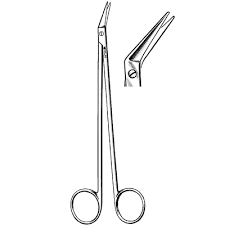Blades numbered 10, 11, 12, and 15 are designed to fit onto this size scalpel handle.
#3
This type of hernia occurs in the groin and is more common in males; it may be direct or indirect depending on its anatomical location.
inguinal hernia
This type of indicator is placed inside a wrapped instrument set and changes color when exposed to sterilization conditions, verifying the pack was processed.
chemical indicator
The circulator notices the OR temperature has dropped below 68°F and the humidity is below 20%. What potential risk does this create for both the patient and equipment?
static sparks (fire risk) and the patient getting cold
This suture type is made of a single strand, has low tissue drag, and is commonly used in areas like the subcuticular layer to minimize scarring.
monofilament suture
 This type of fine vascular scissor is often used to extend arteriotomies
This type of fine vascular scissor is often used to extend arteriotomies
Potts-Smith scissors
This OB/GYN procedure removes the uterus through the vaginal canal and is commonly abbreviated as TVH.
total vaginal hysterectomy
This method of sterilization uses gas and is ideal for heat- and moisture-sensitive items but requires aeration after processing.
ethylene oxide
During an emergency, a scrub tech grabs a fire extinguisher. After pulling the pin, what is the next action, and why is correct technique important?
aim at the base of the fire
Large blood vessels are often occluded using this type of suture technique to prevent slippage and control bleeding after a hemostatic clamp is applied.
stick tie
This large self-retaining abdominal retractor uses a table-mounted post and ring system and is commonly used in procedures like colectomies or hysterectomies.
Bookwalter
This orthopedic procedure involves using a metal rod to stabilize a fractured femur and is inserted into the medullary canal.
intramedullary nailing
This type of sterilizer relies on steam entering the chamber and displacing the air downward, using pressure and heat to sterilize items.
gravity displacement sterilizer
While assisting with a fluoroscopy-guided procedure, you find yourself standing in the radiation zone longer than expected. What two additional safety steps can you take if you can’t move away?
wear a lead apron and use a shield
This technique places lateral sutures just beneath the epithelial layer of skin to promote cosmetic healing and avoid the need for removal.
subcuticular closure
This type of drain uses gravity or capillary action, while its counterpart uses negative pressure to actively remove fluid.
passive drain
In this general surgery procedure, a portion of the colon is resected and may require a temporary or permanent colostomy.
colectomy
These are the required temperature and pressure conditions for a gravity displacement sterilizer.
250°–270°F at 15–17 psi
You’re setting up for a laser procedure when you realize the warning signs aren’t posted and the smoke evacuator is unplugged. What immediate steps should you take to ensure compliance with laser safety protocols?
post the signs, turn on the smoke evacuator, and make sure everyone has laser eye protection?
This tough, slow-healing connective tissue layer must be closed securely with heavy, nonabsorbable, interrupted sutures due to its role in supporting the abdominal wall
fascia
The safe maximum inflation time for this surgical device is 60 minutes for upper extremities and 90 minutes for lower extremities.
pneumatic tourniquet
This OB/GYN procedure involves locating and biopsying the first lymph node that drains the breast and is often done alongside lumpectomy.
sentinel lymph node biopsy
This sterilization monitoring method uses vials containing live bacterial spores to ensure microbial kill has occurred.
biological monitoring
During a laparoscopic procedure, smoke from electrocautery is building in the peritoneal cavity. The anesthesiologist asks for smoke evacuation. What risks are involved if plume is not properly managed, and what PPE should the team use?
During electrosurgery, this item is placed on the patient’s skin to safely return the electrical current back to the generator, preventing burns or injury.
This stapling device simultaneously cuts and staples tissue and is frequently used in bowel resections during GI procedures.
Linear cutter